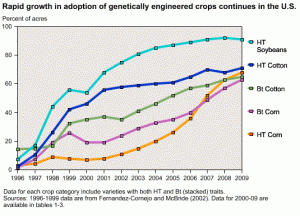¿Querían semilla Roundup Ready? ¡Pues TOMA ROUNDUP READY! Se lo advertimos, ahora no se quejen.
Resistant weeds threaten to cripple Iowa’s agriculture economy
Glyphosate-resistant weeds now established in 19 states
Iowa crop farmers are battling an old problem with potentially new and devastating repercussions for the entire state’s agricultural economy: Herbicide-resistant weeds.
The phenomenon is not all that new, said Mike Owen, a weed specialist at Iowa State University who has been discussing herbicide-resistant weeds since the 1980s. But widespread adoption of certain biotech advances have made matters much more complicated.
It has only been in the last few years that crops have been selectively engineered to tolerate topical application of active ingredients in a specific herbicide. The resistance that weeds have developed to that ingredient — called glyphosate — combined with its widespread adoption, has the potential of costing Iowa producers millions of bushels of produce, and severely crippling the state’s ag-based economy.
An herbicide with glyphosate was introduced by the Monsanto Co. in 1974 under the commercial name Roundup. Roughly 18 years later, the company introduced its first biotech crop, Roundup Ready soybeans, which would tolerate direct application of the glysophate-based herbicide. Modified corn was introduced two years later.
When these glyphosate-resistant crops came onto the market, many hoped and some believed that another herbicide or genetically-modified crop wouldn’t need to be developed. However, over time, crop farmers encountered more and more glyphosate-resistant weeds, and no new herbicide ingredients being developed to control them. Within a decade, some environmental and consumer groups were beginning to question the safety of the Roundup Ready crop line, specifically pointing to the emergence of “super weeds.”
Despite the concerns voiced by some, and increasingly aggressive tactics by Monsanto to protect its seed patents, use of the Roundup Ready crop brands were widely adopted by farmers in Iowa and throughout the nation. While each individual grower had his or her own specific reasons for changing to the Roundup Ready system, Owen believes that larger scale operations’ search for simplicity and convenience as well as corporate marketing played key roles.
Disturbances on the GM front
MARION NESTLE
If you want to know what’s really happening in the world of food and nutrition, the business pages are a good starting place. Today’s New York Times business section documents the “stunning” rise in the price of soybean seeds (up 108% since 2001) and corn seeds (up 135%).
Why care? Genetically modified (GM) varieties are now the majority – and increasingly the vast majority – of crops planted in the United States. The seeds are patented. Farmers cannot harvest and save them. Farmers must buy new patented seeds every year. And since one company – Monsanto – owns most of the patents, it gets to set the price.
USDA keeps track of the rise in use of GM crops. Impressive, no?
The USDA does not track GM sugar beets on this chart, but should. Monsanto also patents GM sugar beets. The USDA approved Monsanto’s sugar beets in 2005. By 2009, 95% of U.S. sugar beets were grown from Monsanto’s patented varieties.
Oops. When it approved the beets, the USDA let them be planted without the required environmental impact statement (EIS). Advocacy groups argued that the beets should not be planted without that assessment. A judge agreed and blocked further plantings. The judge is still sitting on the case. Until he rules, no GM sugar beets can be planted.
We have a similar situation with GM alfalfa. This crop was also approved in 2005 without an EIS and also was taken to court and banned. But now the EIS is done and the USDA has found “no safety concerns.” Perhaps GM alfalfa will be added to the chart next year?
What are we to make of this? Is it a good idea for one company to own most of the seeds planted in the United States? Especially when that company is permitted to enforce its own patent protection and to set its own prices?
The great promise of food biotechnology is that it will feed a hungry planet. Is this the best way to met world food needs? Whatever you think of GM foods, these questions are worth pondering.
Etiquetas: Marion Nestle, Roundup



0 Comentarios:
Publicar un comentario
Suscribirse a Comentarios de la entrada [Atom]
<< Página Principal